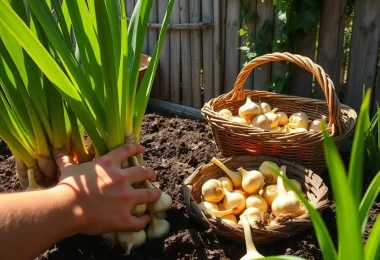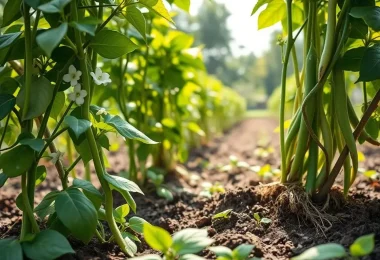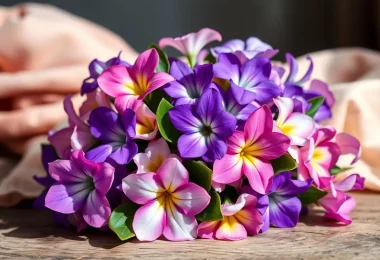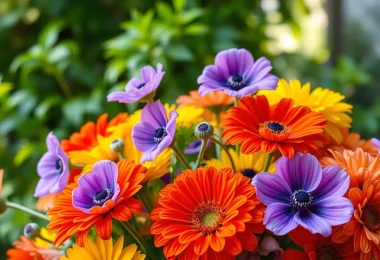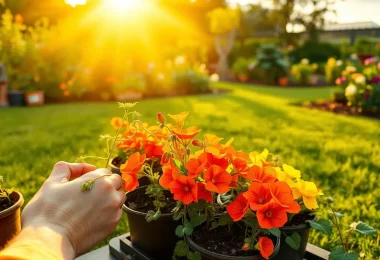Dahlias are a vibrant addition to any garden. They come in many colours and shapes. This guide will help you grow beautiful dahlias, whether you’re new to gardening or have experience.

Key Takeaways
- Discover the right dahlia varieties to suit your garden’s conditions
- Prepare the soil properly to give your dahlias the best start
- Master the step-by-step planting process for optimal growth
- Learn effective watering and fertilising techniques for lush blooms
- Protect your dahlias from common pests and diseases
- Prepare your dahlias for the winter to ensure their return next season
- Design a stunning dahlia garden with vibrant colour combinations
Introduction to Dahlias: Nature’s Vibrant Beauties
Dahlias are stunning flowers that have won the hearts of gardeners everywhere. They come in many colours, shapes, and sizes. This makes them a celebration of nature’s creativity. Dahlias offer gardeners endless ways to make any outdoor space vibrant and eye-catching.
Dahlias are special because of their unique beauty. Their petals range from solid colours to amazing patterns. This creates a visual wonder that excites the senses and sparks the imagination.
Whether you’re experienced or new to dahlias, they can inspire and amaze you. They grow well in many climates and soils. This makes them a favourite for gardens of all sizes and styles.
“Dahlias are the art of the garden, a living canvas that captivates the soul.”
Exploring dahlias reveals a world of varieties, each with its own charm. You’ll find everything from classic ball shapes to whimsical cactus flowers. Gardeners can create stunning displays by choosing colours and forms that complement each other.
Embracing dahlias opens up a world of creative possibilities for gardeners. They can add drama to borders, create vibrant cut-flower displays, or simply enjoy their beauty. Dahlias are a gift from nature that will continue to delight and inspire for years.
related: How to Plant and Grow Rhododendron: A Complete Guide
Choosing the Right Dahlias for Your Garden
Dahlias come in a wide range of varieties, each with its own charm and needs. Whether you want the classic ball-shaped blooms or the dramatic dinner plate varieties, picking the right dahlias is crucial. It ensures your garden is lush and vibrant.
Exploring the Diverse Varieties of Dahlias
The world of dahlias is vast, from the vibrant cactus dahlias to the elegant waterlily varieties. There are many popular dahlia types, including:
- Ball Dahlias: Compact, spherical blooms in a range of hues
- Decorative Dahlias: Large, showy flowers with broad, overlapping petals
- Pom-Pom Dahlias: Tightly-packed, spherical blooms that resemble fluffy pom-poms
- Dinner Plate Dahlias: Massive, dinner plate-sized flowers that make a stunning statement
Identifying the Ideal Growing Conditions
Dahlias love well-drained, nutrient-rich soil and full sun. Before picking your dahlia varieties, think about your garden’s soil, sunlight, and climate. Knowing what each dahlia type needs ensures a vibrant display all season.
| Dahlia Variety | Soil Preference | Sunlight Needs | Climate Suitability |
|---|---|---|---|
| Ball Dahlias | Well-drained, fertile | Full sun | Temperate climates |
| Decorative Dahlias | Rich, well-draining | Full sun | Warm, sunny regions |
| Pom-Pom Dahlias | Nutrient-rich, moist | Full sun to partial shade | Mild, temperate climates |
| Dinner Plate Dahlias | Deeply cultivated, humus-rich | Full sun | Warm, sunny regions |
Preparing the Soil for Planting Dahlias
Dahlias are vibrant and captivating flowers. They need well-draining, nutrient-rich soil to grow well. Preparing the dahlia soil requirements is key to a successful garden.
Soil Requirements for Thriving Dahlias
Dahlias do best in soil with a pH between 6.0 and 7.0. This pH range is perfect for their growth. You can test your soil’s pH at home or ask a local gardening centre.
Dahlias also need soil that is loose, loamy, and drains well. This type of soil lets oxygen in and prevents water from pooling. This stops root rot and other problems.
- Add 2-4 inches of compost or well-rotted organic matter to the soil. It improves structure and nutrients.
- If your soil is heavy or clay-like, mix in sand or perlite. It helps with drainage.
- Make sure the planting area gets at least 6 hours of direct sunlight a day. This is for the best results.
By preparing your dahlia soil requirements well, you’re setting your dahlias up for success. They will bloom beautifully all season long.

Planting Dahlias: Step-by-Step Guide
Planting dahlia tubers is key to a vibrant dahlia garden. A structured approach ensures dahlias start well. Let’s look at how to plant dahlias for a stunning display.
- Timing: Plant dahlia tubers in spring, around April or May. Wait until frost risk has passed.
- Site Selection: Pick a spot with at least 6 hours of sunlight. Dahlias love well-drained, rich soil.
- Soil Preparation: Add compost or manure to the soil. This improves drainage and fertility. Make sure the soil is easy for roots to grow.
- Planting Depth: Dig a hole 6-8 inches deep. Place the tuber with the eye up. Cover it, leaving 2 inches at the top exposed.
- Spacing: Plant tubers 18-24 inches apart. This lets them get air and nutrients.
- Watering: Water well after planting. Keep the soil moist all season.
By following these steps, gardeners can ensure their dahlia planting succeeds. They’ll enjoy a beautiful display of how to plant dahlias in their garden.

“Dahlias are the divas of the garden, commanding attention with their bold, colourful blooms.”
Caring for Dahlias Throughout the Growing Season
Looking after your dahlia plants is key for lots of colourful blooms. This guide covers watering and fertilising to help your dahlias grow well all season.
Watering Techniques for Lush Dahlias
Watering your dahlias right is vital for their health. Give them 1-2 inches of water each week. This helps their roots grow deep.
Don’t water too often or too little. Water in the morning or evening to save water. Change how often you water based on the weather and your plants.
Fertilising Dahlias for Optimal Growth
Fertilising regularly helps your dahlias grow strong and bloom well. Use a balanced, water-soluble fertiliser every 2-3 weeks. Follow the instructions on the product.
You can also use slow-release granular fertiliser at the start of the season. But, don’t overdo it. Too much fertiliser can make leaves grow too much, not flowers.

Learning how to care for dahlias, from watering to fertilising, will reward you with beautiful blooms all season. Remember, each dahlia type might need something different. So, be ready to adjust your care as needed.
Staking and Supporting Dahlias
As dahlias grow taller, they need staking and support to avoid damage. This step is key to keeping your blooms upright and healthy all season.
Using sturdy canes or poles is a popular dahlia staking method. Place these around the plant and tie the stems with soft materials like plant ties or twine. This keeps dahlias upright and improves air flow, reducing disease risk.
- Use wooden or metal canes, about 6-8 feet tall, for a strong support.
- Place canes around the plant, making sure they’re secure and evenly spaced.
- Tie stems to canes with soft materials, being careful not to harm the plant.
A wire cage or tomato cage is another good dahlia support choice. These can be set up around the plant, offering a framework for stems. Their open design also helps with air flow, lowering disease risk.
It’s crucial to check and adjust staking or support regularly as dahlias grow. This ensures they stay supported and can reach their full height.

“Proper staking and support are essential for growing healthy, vibrant dahlias. With the right techniques, you can ensure your dahlias stand tall and proud in your garden.”
Combating Common Pests and Diseases Affecting Dahlias
Dahlias are beautiful additions to any garden. But, they can face pests and diseases. Knowing how to deal with these issues helps your dahlias grow strong and healthy. Let’s look at common problems and how to solve them.
Dahlia Pests: Unwelcome Visitors
Aphids, spider mites, and thrips are common pests of dahlias. These tiny bugs can harm your plants, slowing their growth. To fight these pests, try these steps:
- Check your plants often for pests and act quickly.
- Use natural pest control, like ladybugs or neem oil.
- Keep your garden clean by removing sick plants.
Dahlia Diseases: Recognising and Treating
Dahlias can get fungal infections like powdery mildew and botrytis. These can turn leaves yellow, wilt them, and even kill your plants. Here’s how to handle these diseases:
- Make sure dahlias have good air flow to stop fungi.
- Use fungicides, like copper-based products, early on.
- Get rid of any sick parts to stop the disease from spreading.
By watching for pests and diseases and using these tips, you can keep your dahlias healthy and colourful all season.

| Common Dahlia Pests | Symptoms | Treatment |
|---|---|---|
| Aphids | Wilting, stunted growth, distorted foliage | Organic pest control, introduction of beneficial insects |
| Spider Mites | Discoloured, webbed foliage, premature leaf drop | Neem oil, regular plant inspection and cleaning |
| Thrips | Silvery or speckled leaves, flower damage | Horticultural oils, insecticidal soaps, beneficial insects |
Deadheading Dahlias for Continuous Blooms
Keeping your dahlia garden vibrant and full of life is all about deadheading. This simple method helps your dahlias bloom continuously. By removing old flowers, you help them focus on growing new, beautiful blooms.
Proper Deadheading Techniques
Learning to deadhead dahlias is easy and very rewarding. Here’s how to keep your dahlias looking their best:
- Find the old flowers. Look for any that are wilting, drooping, or turning brown.
- Use sharp scissors or pruning shears to cut the stem just above a healthy leaf or bud.
- Make a clean, angled cut to help the plant heal and avoid disease.
- Throw away the old flowers to stop pests and diseases from spreading.
- Do this every few days to keep your dahlias blooming brightly.
Spending a little time deadheading your dahlias will make them bloom longer. It also helps them grow bushier and look better in your garden. For anyone who loves dahlias, dahlia deadheading is a must.
“Deadheading dahlias is one of the most rewarding tasks in the garden. It’s amazing to see how a simple snip can rejuvenate the plants and keep them flowering for weeks on end.”
| Benefits of Deadheading Dahlias | Challenges of Not Deadheading |
|---|---|
| Promotes continuous blooms | Plants become leggy and unattractive |
| Encourages bushier, healthier growth | Flowering period is shortened |
| Maintains an aesthetically pleasing garden | Plants may become susceptible to pests and diseases |
Overwintering Dahlias: Preparing for the Next Season
As autumn arrives, it’s time to think about overwintering your dahlia plants. This process keeps them alive through winter, ready for next year’s blooms. Learning how to overwinter dahlias is crucial for their health and beauty.
Wait for the first frost to kill the foliage before lifting the tubers. This usually happens in late autumn or early winter. Use a garden fork to lift them carefully, avoiding damage. Remove excess soil but don’t wash the tubers to prevent rot.
- Trim the stems back to about 6 inches (15 cm) above the tubers.
- Let the tubers dry in the sun for a few hours, then store them in a cool, dark place like a basement or garage.
- Store them in a breathable container, like a paper or mesh bag, or a cardboard box with holes for air.
Check the tubers regularly for rot or disease during winter. If you find any, throw away the affected tubers to stop the problem from spreading. Keep the storage area cool, between 40-50°F (4-10°C), for best results.
| Dahlia Overwintering Checklist | Tips |
|---|---|
| Lift tubers after first frost | Gently lift with a garden fork, avoiding damage |
| Trim stems to 6 inches (15 cm) | Allows for easy replanting in spring |
| Dry tubers in the sun | Helps prevent rot during storage |
| Store in a cool, dry, dark place | Maintain temperature between 40-50°F (4-10°C) |
| Monitor for rot or disease | Discard any affected tubers immediately |
By using these dahlia overwintering tips, your tubers will be ready for next year’s blooms. A bit of care now will make your dahlias bloom beautifully for years.
Designing a Dahlia Garden: Colour Combinations and Layouts
Dahlias are a gardener’s dream, offering vibrant colours and captivating blooms. Designing a stunning dahlia garden is limitless. By choosing the right colours and layouts, you can create a breathtaking oasis.
Colour Harmony in the Dahlia Garden
Dahlias come in a wide range of colours, from bold reds to delicate pastels. Pairing warm and cool colours creates a stunning contrast. For example, ‘Fiesta’ and ‘Café au Lait’ look great with ‘Blue Bayou’ and ‘Purple Haze’.
Monochromatic palettes are also impactful. Imagine a bed of dahlias in different shades of pink. From ‘Café au Lait’ to ‘Kelvin Floodlight’, it’s a sight to behold.
Captivating Layouts for Dahlia Gardens
When designing your dahlia garden, consider the bloom sizes and growth habits. Plant taller dahlias like ‘Café au Lait’ at the back. Shorter varieties like ‘Karma Choc’ and ‘Karma Pacifica’ work well in the front.
Grouping dahlias of the same variety creates a stunning display. This approach highlights each cultivar’s unique features.
| Dahlia Variety | Bloom Size | Colour | Growth Habit |
|---|---|---|---|
| Café au Lait | Large | Soft Cream | Tall |
| Karma Choc | Medium | Dark Burgundy | Compact |
| Karma Pacifica | Small | Lavender | Dwarf |
| Fiesta | Large | Orange and Red | Tall |
| Blue Bayou | Medium | Deep Purple | Medium |
| Purple Haze | Medium | Lavender-Purple | Medium |
| Kelvin Floodlight | Large | Bright Pink | Tall |
By choosing the right colours and layouts, you can create a stunning dahlia garden. With so many options, the possibilities are endless.
Cutting and Displaying Dahlias: Bringing Indoor Beauty
Dahlias add colour and beauty to any garden. They also make great cut flowers. By learning how to cut and arrange them, you can bring their beauty indoors. This will make your home more charming.
Preserving Cut Dahlias for Longer Enjoyment
To keep your cut dahlias fresh, follow these tips:
- Harvest blooms in the early morning or evening, when the plant is most hydrated.
- Use sharp, clean secateurs to make a clean diagonal cut at the stem base, leaving at least 6 inches of stem.
- Immediately place the cut stems in a clean vase filled with cool water, and change the water daily.
- Add a floral preservative to the water to prolong the life of your cut dahlias.
- Store the vase in a cool, shaded area, away from direct sunlight and heat sources.
- Regularly remove any wilted or damaged petals to maintain the flower’s pristine appearance.
With a bit of care, your cut dahlias can last up to two weeks. This brings the garden’s colours indoors.
| Cutting Dahlias | Displaying Dahlias | Preserving Cut Dahlias |
|---|---|---|
| Harvest blooms in the early morning or evening | Use clean, sharp secateurs for cutting | Place stems in clean vase with cool water |
| Leave at least 6 inches of stem | Arrange in a variety of vases and containers | Add floral preservative to prolong freshness |
| Immediately place in water | Group blooms by colour or variety | Store in cool, shaded area |
“The true secret of happiness lies in taking a genuine interest in all the details of daily life.” – William Morris
Learning to cut and display dahlias brings garden beauty indoors. You can enjoy their vibrant beauty for weeks.
Dahlia Companion Plants: Enhancing Your Garden
Creating a stunning garden is easier with the right plant pairings. Dahlias stand out with their bright flowers and leaves. But, adding the right plants around them can make your garden even more beautiful and balanced.
Annuals like cosmos, zinnias, and marigolds are great with dahlias. They match the dahlias’ bold colors and add a playful vibe. Perennials such as coneflowers, black-eyed Susans, and liatris also look amazing. Their long-lasting flowers mirror the dahlias’ beauty.
For a calm and elegant look, try foliage plants like ornamental grasses, ferns, and hostas. These plants add depth and texture. They let the dahlias shine, making your garden both peaceful and eye-catching.
- Annuals: cosmos, zinnias, marigolds
- Perennials: coneflowers, black-eyed Susans, liatris
- Foliage plants: ornamental grasses, ferns, hostas
Choosing the right dahlia companion plants can make your garden stunning. It also helps your dahlias grow well in a healthy environment.
Dahlia Societies and Resources for Enthusiasts
If you love growing dahlias, you’re in luck. There are many societies, clubs, and online resources out there. These groups let you meet others who share your passion. You can learn and grow together in the world of dahlias.
Local dahlia societies are great places to start. They hold meetings, workshops, and flower shows. Here, you can swap tips, see different dahlias, and meet other gardeners. National groups like the Royal Horticultural Society in the UK and the American Dahlia Society in the US also have lots to offer.
Looking to learn more? There are books, magazines, and websites all about dahlias. They cover everything from how to plant and care for dahlias to creative ways to use them in your garden. Whether you’re new to dahlias or have been growing them for years, there’s something for everyone.
FAQ
What are the key factors to consider when choosing the right dahlias for my garden?
When picking dahlias, think about the soil, sunlight, and climate. Also, consider the size, shape, and colour of the blooms. It’s key to find varieties that will do well in your garden.
How do I properly prepare the soil for planting dahlias?
Dahlias need well-draining, rich soil. Before planting, add compost or aged manure to improve the soil. Also, check the soil pH and adjust it to 6.0 to 7.0 for best growth.
What is the best way to plant and care for dahlias throughout the growing season?
Plant dahlias correctly and water them regularly. Use about 1 to 2 inches of water per week. Fertilise them with a balanced feed to keep them healthy.
How do I properly stake and support my growing dahlia plants?
Dahlias can grow tall and need support. Use canes, stakes, or tomato cages to keep them upright. Tie the plants to the supports regularly.
How can I protect my dahlias from common pests and diseases?
Dahlias face pests like aphids and diseases like powdery mildew. Use organic pesticides and ensure good air circulation. Proper spacing helps too.
What is the best way to overwinter my dahlia tubers for the next growing season?
After the first frost, lift and dry the tubers. Store them in a cool, dry place over winter. In spring, divide and replant for more blooms.
How can I design a visually stunning dahlia garden?
Dahlias come in many colours and sizes. Mix different types for a stunning display. Use various colours and patterns to create a beautiful garden.
What are the best practices for cutting and displaying dahlias indoors?
Dahlias are great for indoor arrangements. Cut them with clean secateurs, leaving a few inches of stem. Use floral preservatives in water to keep them fresh. Combine them with other flowers for a beautiful display.



